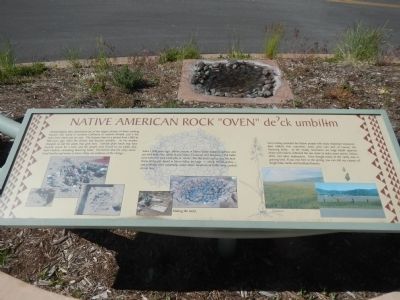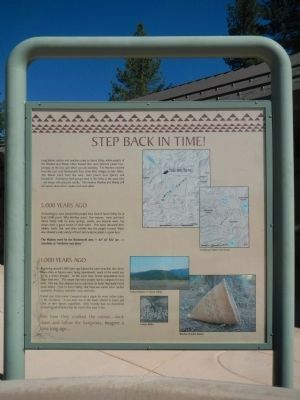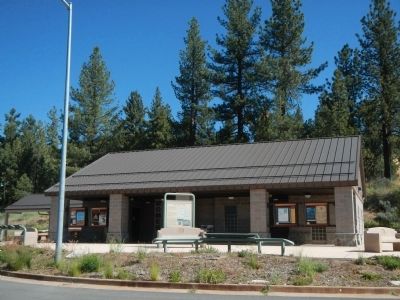Near Beckwourth in Plumas County, California — The American West (Pacific Coastal)
Step Back In Time
Inscription.
Long before settlers and ranchers came to Sierra Valley, native people of the Washoe and Maidu tribes hunted deer and collected plants here, perhaps on the very spot you are standing. The Washoe traveled fro the east, over Beckwourth Pass, from their villages at Lake Tahoe. The Maidu came from the west, from places near Quincy and Greenville. Sometimes both groups were in the valley at the same time – not always with pleasant results. The modern Washoe and Maidu still tell stories about their clashes with each other.
5,000 Years Ago
Archaeologists have learned that people have lived in Sierra Valley for at least 5,000 years! Why did they come? Two reasons: water and food. Sierra Valley, with its many springs, creeks, and artesian wells, has always been a good source of fresh water. This water attracted deer, rabbits, birds, fish, and other wildlife that the people hunted. Water also allowed a wide variety of food and medicine plants to grow here.
The Washoe word for the Beckwourth area – do? Ca? kila? am – translates as “medicine-root place.”
1,000 Years Ago
Beginning around 1,000 years ago (about the same time as the classic Maya cities in Mexico were being abandoned), much of the world was hit by a severe drought. At the same time, human populations were larger than ever. This meant that more people had to compete for less food. One way they adapted was to rely more on foods they hadn’t used much before – here in Sierra Valley, that food was camas (also spelled quamash), Brodiaea, and other roots and bulbs.
Camas root (Latin name Camassia), was a staple for many Indian tribes in the Northwest – it was even one of the foods offered to Lewis and Clark on their famous expedition. Only recently have we discovered archaeological evidence that the local tribes used it also.
See how they cooked the camas – look down and follow the footprints. Imagine a time long ago.
Topics. This historical marker is listed in this topic list: Native Americans.
Location. 39° 49.41′ N, 120° 24.809′ W. Marker is near Beckwourth, California, in Plumas County. Marker can be reached from Feather River Highway (Route 70), on the left when traveling west. Touch for map. Marker is at or near this postal address: 78646 Feather River Highway, Beckwourth CA 96129, United States of America. Touch for directions.
Other nearby markers. At least 8 other markers are within 4 miles of this marker, measured as the crow flies. Sierra Valley History (here, next to this marker); James P. Beckwourth Ranch and Trading Post (within shouting distance of this marker); Beckwourth Trail – The Road Forks (within shouting distance of this marker);
Jim Beckwourth Trading Post (approx. 0.4 miles away); James P. Beckwourth (approx. 0.4 miles away); Hope Lodge No. 234 F & AM (approx. 1.8 miles away); Beckwourth Trail - Head Waters of Feather River (approx. 2 miles away); Plumas County Honor Roll World War Two and Korea and Vietnam (approx. 3.4 miles away). Touch for a list and map of all markers in Beckwourth.
More about this marker. This marker is located at the Lester T. Davis Safety Roadside Rest Area west of Beckwourth.

Photographed By Barry Swackhamer, June 4, 2013
3. Native American Rock “Oven” de?ck umbil+m
Archaeologists have discovered one of the largest clusters of these cooking features ever found in northern California or western Nevada, just a few miles from where you are now. The features date to a period from 1,000 to 500 years ago, when the climate had become unstable. As the weather changed, so did the plants that grew here. Familiar plant foods may have become scarce for a time, and the people were forced to eat plants they hadn’t before – including flowering bulbs. We believe that the many stone-lined hearths and ovens in Sierra Valley are evidence of the change.
Some 1,000 years ago, Native people in Sierra Valley began to harvest and eat wild bulbs like camas (Latin Name Camassia) and Brodiaea.The bulbs were baked in rock-lined pits or “ovens” like the exact replica you see here. Some of the pits found in Sierra Valley are huge – nearly 10 feet across – and probably were communal ovens where hundreds of bulbs were cooked at one time.
Sierra Valley provided the Native people with many important resources: deer, rabbits, fish, waterfowl, water pine nuts and, of course, the flowering bulbs. In the nearby mountains are huge basalt quarries where tool makers collected the raw stone to make arrow points, knives, drills, and others implements. Even though much of the valley now is grazing land, if you visit in the spring, you can still see carpets of bright-blue camas and brodiaea flowers.
Some 1,000 years ago, Native people in Sierra Valley began to harvest and eat wild bulbs like camas (Latin Name Camassia) and Brodiaea.The bulbs were baked in rock-lined pits or “ovens” like the exact replica you see here. Some of the pits found in Sierra Valley are huge – nearly 10 feet across – and probably were communal ovens where hundreds of bulbs were cooked at one time.
Sierra Valley provided the Native people with many important resources: deer, rabbits, fish, waterfowl, water pine nuts and, of course, the flowering bulbs. In the nearby mountains are huge basalt quarries where tool makers collected the raw stone to make arrow points, knives, drills, and others implements. Even though much of the valley now is grazing land, if you visit in the spring, you can still see carpets of bright-blue camas and brodiaea flowers.
Credits. This page was last revised on June 16, 2016. It was originally submitted on June 21, 2013, by Barry Swackhamer of Brentwood, California. This page has been viewed 423 times since then and 14 times this year. Photos: 1, 2, 3. submitted on June 21, 2013, by Barry Swackhamer of Brentwood, California. • Syd Whittle was the editor who published this page.

